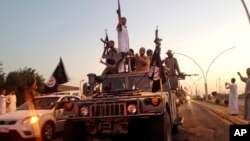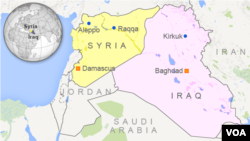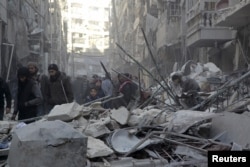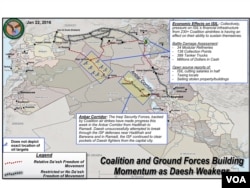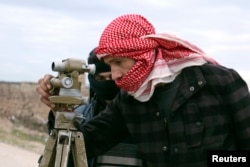Some U.S. officials are heralding new intelligence on the number of Islamic State (IS) fighters as a sign the tide is starting to turn in the battle against the terror group but there are concerns the self-declared caliphate’s larger, global strategy remains very well intact.
The terror group, also known as ISIL or ISIS, now has a force in Iraq and Syria of just 19,000 to 25,000 fighters according to the most recent assessment, the White House said Thursday.
National Security Council spokesperson Emily Horne called it “the lowest assessed range since we began conducting rigorous reviews of the group’s manpower.”
Earlier estimates had put the number of IS frontline fighters at anywhere from 20,000 to 32,000, including what defense officials said were about 17,500 “hardcore members.”
The new, lower estimate reflects a variety of factors, including battlefield deaths, desertions and recruiting shortfalls.
“They continue to be a substantial threat, but the potential numbers have declined,” said White House spokesman Josh Earnest. “ISIL is having more difficulty than they’ve had before in replenishing their ranks.”
No 'Knockout' Punch
The downgrade of the IS force in Iraq and Syria comes almost a year-and-a-half after the U.S. and its coalition partners began launching airstrikes against the group, credited with killing as many as 28,000 fighters. But until recently, U.S. officials had said IS was able to replenish its ranks, in large part due to a constant influx of about 1,000 foreign fighters a month, many coming across the porous Turkish-Syrian border.
“That’s a testament to the efforts of our partners on the ground,” said Earnest, who credited Turkey with cracking down on the border. “It also is a testament to the success that we’re having in starting to staunch the flow of foreign fighters to Iraq and in Syria.”
Still, there is a high degree of wariness.
“ISIL is not likely to go down by a single knockout punch,” a U.S. official told VOA on condition of anonymity. But he added, “The coalition’s repeated body blows against ISIL are wearing on the group."
On the Rise in Libya
Yet even as IS’s numbers appear to be on the decline in Iraq and Syria, the group’s numbers in Libya are on the rise.
Pentagon officials Thursday confirmed figures previously reported by VOA that IS is now up to about 5,000 fighters in Libya - and growing.
Included in that number, officials say, are numerous key military commanders and officials, including Abu Ali al-Anbari, a top deputy who previously reported directly to Islamic State leader Abu Bakr al Baghdadi in Syria.
Such direct linkage to IS’s core leadership is unique among the group’s many self-declared provinces.
“That’s what fundamentally different about Libya,” says a U.S. official also speaking on condition of anonymity. “Libya is a true branch.”
At the White House Thursday, spokesman Josh Earnest tried to downplay concerns about the growing IS presence there, saying it is “dangerous but it’s different” from the group’s self-declared caliphate in Syria and Iraq.
“We’ve been mindful of these other places,” he said. “We’re going to continue to watch how the threat in Libya evolves and we’re going to continue to be prepared to take action.”
Tightening its Grip in Libya
Already, the Pentagon has put special forces on the ground in Libya to look for groups “who might be worthy of U.S. support” while U.S. and European diplomats work to support a potential unity government.
But there are fears, the longer it takes for the U.S. and its European allies to act, the stronger IS’s grip on Libya will become.
“The situation in Libya grows much more grave by the day,” said Nathaniel Barr, a research manager at Valens Global, who cautions the drop in IS’s force size in Iraq and Syria is not entirely due to U.S. and coalition efforts.
“A large part of that is the Islamic State redirecting foreign fighters, specifically foreign fighters from the Sahel, North Africa and parts of east Africa as well to Libya rather than Syria and Iraq,” he said.
“This is a long term approach,” Barr added. “Sirte could be the third capital of the Islamic State after Raqqa and Mosul.”
Smaller Force May Be Strategic
Officials and analysts also warn against reading too much into the smaller IS fighting force in Iraq and Syria, saying the group’s leadership is showing few signs of conceding.
“ISIS can actually survive even if it loses its terrain inside Iraq and Syria,” says to Harleen Gambhir, a counterterrorism analyst at the Institute for the Study of War.
U.S. officials estimate IS has lost 40 percent of the territory it held at its peak in Iraq and anywhere from five to 30 percent of the territory it once claimed in Syria.
But Gambhir says how much territory has been lost is not as important as where that territory is.
“That pressure is on the edges of its core areas of control,” she said. “No one is forcing Isis to defend its core areas of control along the Iraqi-Syrian border, along the Euphrates River Valley.”
There are also concerns that the ongoing civil war in Syria could play to the terror group’s advantage, as Russia targets the multitude of opposition groups arrayed against the regime of Syrian President Bashar al Assad
“It’s unlikely any party will try to expel ISIS from eastern Syria or try to hold that terrain because so many actors are focused on the fight in Western Syria,” Gambhir warned.
And the U.S. and it’s allies could see their options dwindle.
“As Russia slowly wears down and radicalizes the Syrian opposition, it’s really taking away any kind of anti-ISIS force that we would want to deploy,” she said.
VOA's Pentagon correspondent Carla Babb and White House correspondent Mary Alice Salinas contributed to this report.




